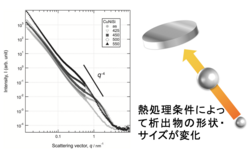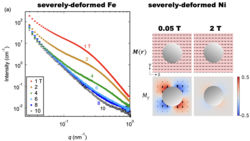
Oba, Yojiro
| Affiliation | Department of Mechanical Engineering |
|---|---|
| Title | Associate Professor |
| Fields of Research | Materials Science, Structural Characterization |
| Degree | Dr. Eng. (Keio University) |
| Academic Societies | Japan Institute of Metals and Materials, Iron and Steel Institute of Japan, Japanese Society for Neutron Science |
| oba@me Please append ".tut.ac.jp" to the end of the address above. |
|
| Researcher information URL(researchmap) | Researcher information |
Research
Nanostructures often play a dominant role in properties of materials, such as mechanical properties of structural materials, conductive properties of metals, magnetic properties of magnetic materials, and critical current of superconductors. X-ray and neutron are powerful probe to characterize the nanostructures in materials, which are difficult to observe by conventional microscopes. I am studying the nanostructures using X-ray and neutrons to clarify the formation mechanisms and contributions to the properties of the nanostructures. The results will lead the development of advanced high-performance materials.Theme1:Formation and strengthening mechanisms of nanoscale precipitates in metals
Overview
The nanoscale precipitates provide higher mechanical strength due to the suppress of dislocation motion known as precipitation strengthening. The precise characterization and optimization of the annealing condition for the precipitation are required to obtain maximum efficiency of strengthening. For this purpose, small-angle X-ray scattering (SAXS), small-angle neutron scattering (SANS), and other quantum beam measurements are used in this study.
Selected publications and works
H. Sasaki, S. Akiya, Y. Oba, M. Onuma, A. D. Giddings, and T. Ohkubo, Materials Transactions 63, 1384-1389 (2022).
Y. Oba, S. Morooka, K. Ohishi, J. Suzuki, and T. Tsuchiyama, ISIJ International 62, 173-178 (2022).
Theme2:Characterization of magnetic structure using neutron magnetic scattering
Overview
Neutron has a magnetic moment and can therefore observe magnetic structures in materials. This characteristic is powerful to clarify the generation mechanism of magnetic properties and further development of advanced magnetic materials. In addition, the magnetic structures often reflect the change in crystallographic structures, such as lattice defects and precipitates. Hence, the neutron scattering is also useful to precisely characterize subtle change in the nanostructures in materials. This study aims to provide knowledge of the nanostructures as well as magnetic structures using neutron scattering.
Selected publications and works
V. D. Zaporozhets, Y. Oba, A. Michels, and K. L. Metlov, Journal of Applied Crystallography 55, 592-600 (2022).
Y. Oba, M. Bersweiler, I. Titov, N. Adachi, Y. Todaka, E.P. Gilbert, N.-J. Steinke, K. L. Metlov, and A. Michels, “Role of higher-order effects in spin-misalignment small-angle neutron scattering of high-pressure torsion nickel”, Physical Review Materials 5, 084410/1-9 (2021).
M. Bersweiler, E. P. Sinaga, I. Peral, N. Adachi, P. Bender, N.-J. Steinke, E. P. Gilbert, Y. Todaka, A. Michels, and Y. Oba, Physical Review Materials 5, 044409/1-7 (2021).
Y. Oba, N. Adachi, Y. Todaka, E. P. Gilbert, and H. Mamiya, Physical Review Research 2, (2020) 033473/1-6.
Title of class
Physics 3



